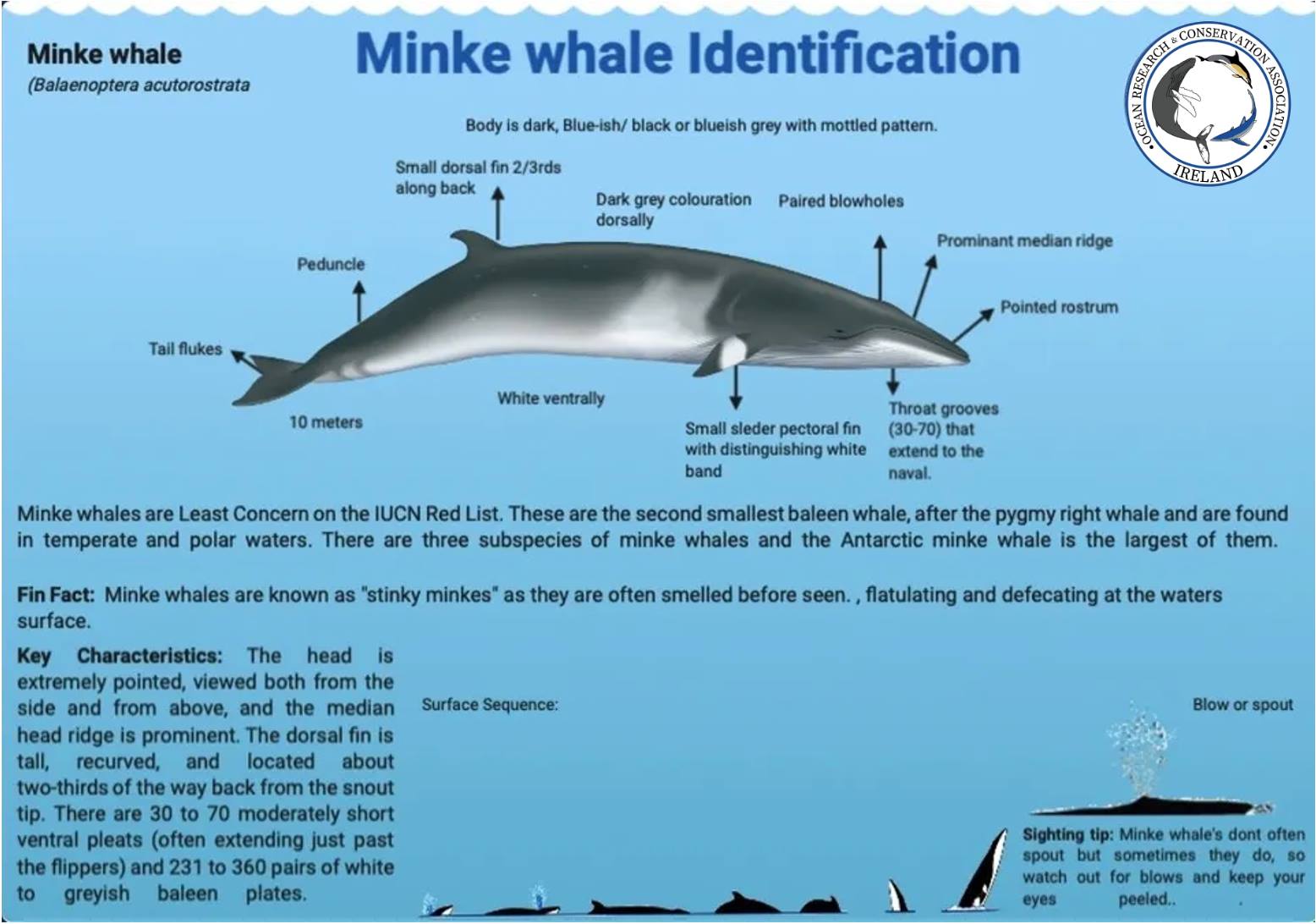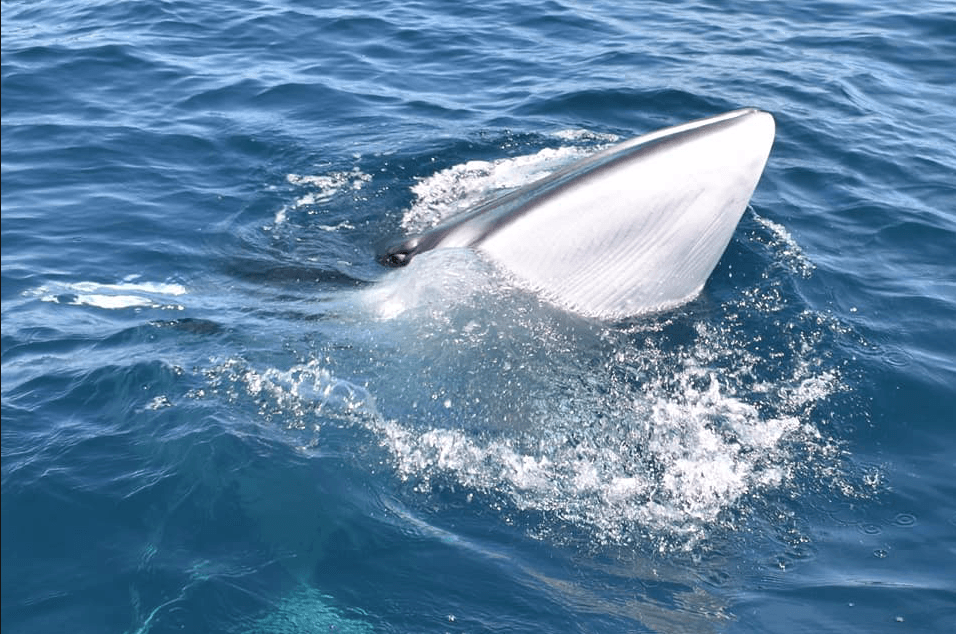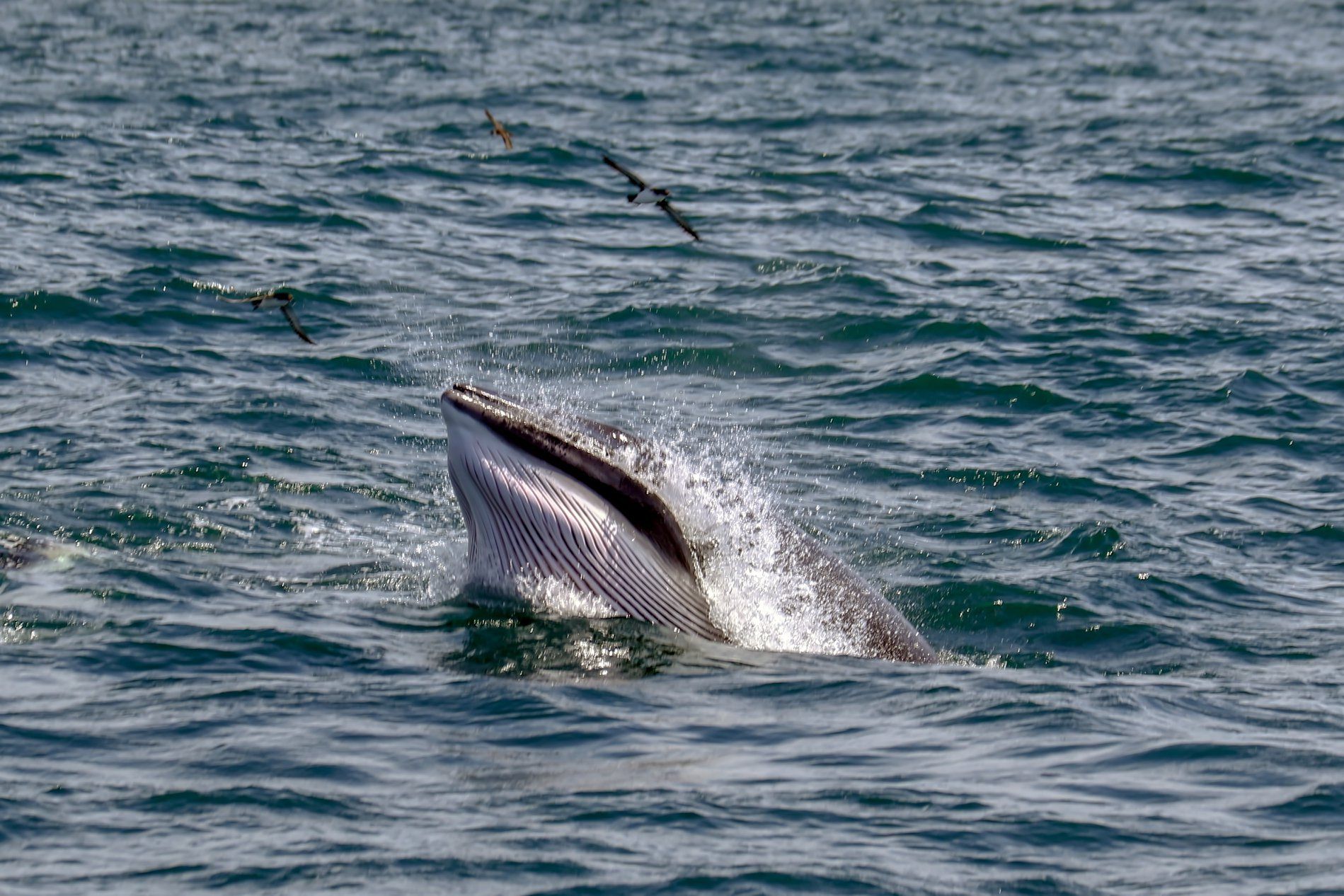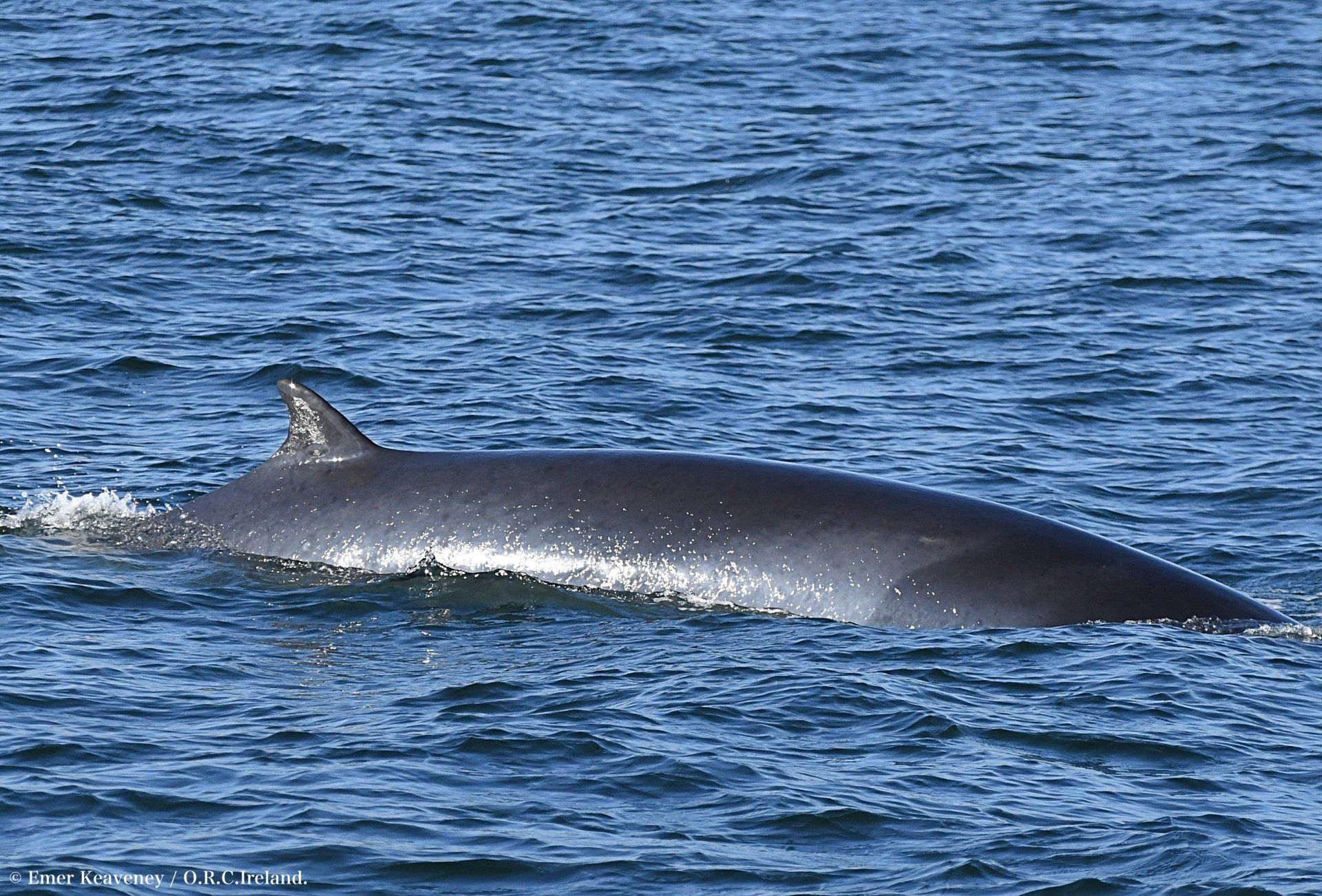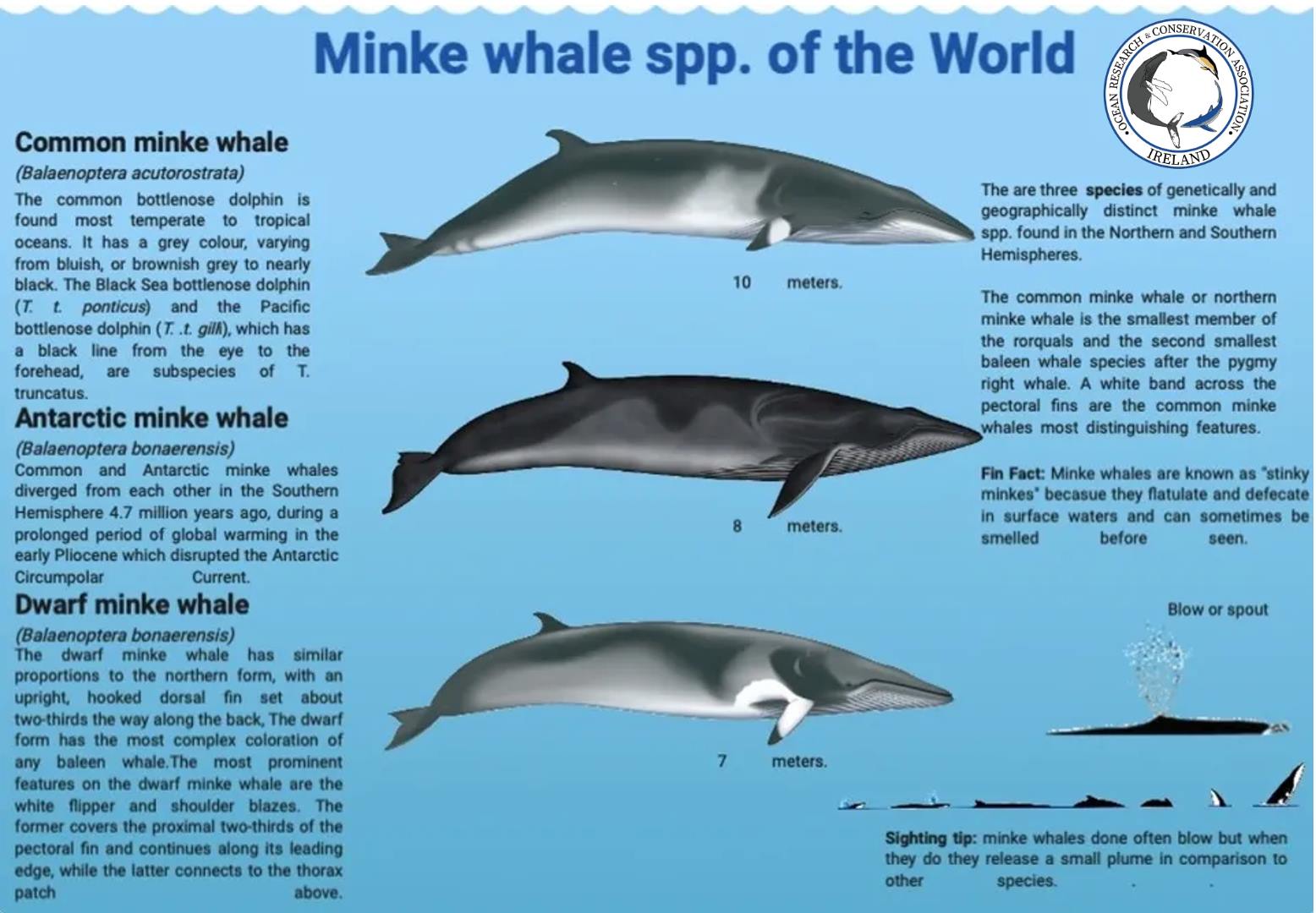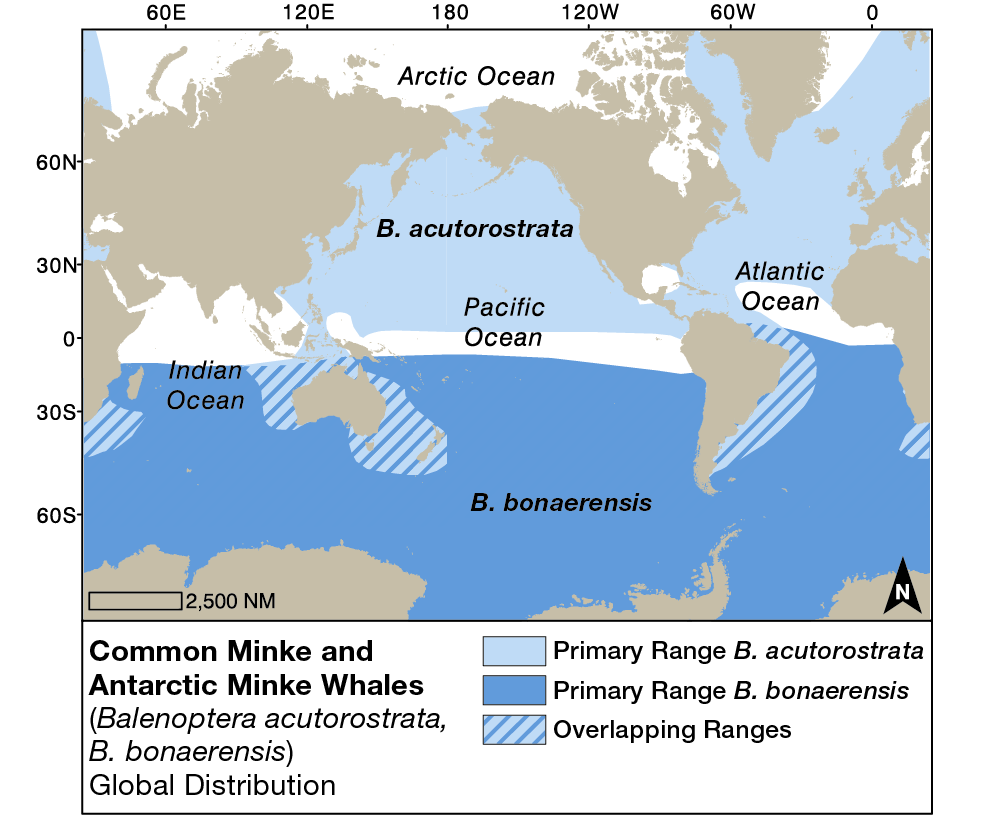Minke Whale
(Balaenoptera acutorostrata)
Minke whale photographed on-board Baltimore Wildlife Tours. Source: Emer Keaveney/O.R.C.Ireland.
Next Species ---->
<-----Previous Species
Classification:
Kingdom: Animalia
Phylum: Chordata
Class: Mammalia
Order: Artiodactyla
Infraorder: Cetacea
Family: Balaenopteridae
Genus:
Balaenoptera
Species:
B. acutorostrata
Get the Facts:
Minke whales are Ireland's smallest and most abundant baleen whale species. Minke whales are typically seen once and then may disappear for up to five minutes before reappearing in an unpredictable location, earning them the nickname '‘slinky minke'. They are also sometimes smelled before being seen giving them the alternative nickname "stinky minke".
Species Identification:
Minke whales are generally easy to distinguish from other rorquals due to their small size, reaching a max length of 10 meters - earning them the title of the smallest baleen whale. Minke whales colouration is distinctive: dark grey dorsally, with intermediate streaks or lobes of varying shades along the flanks and white underneath. Some minke whale's streaks and lobes of various shades extend onto the back and behind the head. Northern and Southern Hemisphere minke whales have distinctive white patches on their pectoral fins which make them easy to identify. These flipper patches are absent on Antarctic subspecies. Their dorsal fins are tall and curved and are located 2/3rds of the way along their back. Minke whales heads are extremely pointed with a prominent median ridge and as they surface their heads often rise briefly above the water. They have a small bushy blow that is not easily seen from a great distance and diffuses quickly.
Diet:
In the Northern Hemisphere, minke whales feed primarily on small schooling fish (capelin, sand-eels, cod, herring and pollock). In the Southern Hemisphere they mostly feed on krill, although in some areas will also take copepods.
Habitat:
Minke whales can be found offshore but on their summer feeding grounds they tend to occupy coastal and inshore waters, entering bays and inlets. The winter breeding distribution of minkes whales is poorly documented and this lack of knowledge is one of the main mysteries of the minke whale. Minke whales are the most frequently recorded baleen whale in Irish waters and can be seen off most headlands throughout the year along the entire Irish coast, although most sightings are recorded from the south and west coasts between May and October. The highest relative abundance of minke whales were recorded off the south and southwest coasts of Ireland in the autumn and in the western Irish Sea in the spring - peaks are thought to have occurred due to the presence of large concentrations of pelagic schooling fish. They are mostly seen in shallow waters (<200m) over the Irish Shelf, as well as shallower areas such as the Porcupine and Rockall Banks. They are rarely seen beyond the continental shelf. There appears to be a seasonal inshore migration of minke whales during the summer and autumn.
Behaviour:
A minke whale's typical breathing sequence consists of 5-8 blows at intervals less than one minute, followed by 3-8 shallow dives before a deep dive which typically lasts 3-5 minutes, but may last up to 20 minutes. Minke whales lunge feed when foraging on schooling prey. They very rarely fluke or raise their tails above the surface of the water before they take a dive. They also rarely have a visible blow although sometimes a small blow can be seen when the animal lunges through a bait ball. Minke whales are often difficult to approach but some, especially juveniles, may be inquisitive and approach boats. Minke whales have been occasionally observed breaching and spy-hopping off the south coast of Ireland.
Social Structure:
Minke whales are often seen alone but may be seen in small groups of 3-5 individuals, although on rare occasions they have been seen in groups of up to 100 in rich feeding areas. Seasonal sex and age segregation is pronounced in minke whales. This means that whales will group up and travel in certain age and sex classes and will appear in areas at different times. For example, during the summer in the North Atlantic, sexual and age segregation occurs with the mature females predominating in the early summer months in the coastal regions and also in the most northern regions during most of the season whilst the males migrate north in open seas. The immature whales are believed to migrate slightly later and remain further south.
Reproduction:
Mating behaviour has not been directly observed for this species. The gestation period for minke whales is 10 months, and calves measure 2.4 to 2.8 m at birth. The newborns nurse for five to 10 months. Breeding peaks during the summer months. Calving is thought to occur every two years. The timing of conception and birth varies between region. In the North Atlantic conception takes place from December to May with a peak month of February with birth taking place from October to March with a peak in December. In the North Pacific off Japan there appears to be two phases of conception, the majority of which occurs from February to March but also from August to September, with births occurring from December to January and June to July. In the Yellow Sea stock these two phases have not been noted with conception occurring from July to September and birth peaking from May to June. In the Southern Hemisphere conception takes place from June to December with a peak in August and September. Peak birth time occurs from July to August.
Vocalisations:
Like all baleen whales, minke whales lack the system of air sacs and sound-generating ‘phonic lips’ in the forehead region above the skull, that are found in toothed whales, such as dolphins. Baleen whales lack vocal chords, but sounds are produced in the larynx. Minke whales produce a range of sounds described as thump trains, ratchets, clicks and grunts (Winn and Perkins 1976; T.J. Thompson et al. 1979, Richardson et al. 1995). In the Atlantic Ocean, click series, frequency-modulated 400 msec downsweeps at around 80 Hz and pulsive calls sweeping from around 50-35 Hz have been recorded.
Lifespan:
Minke whales generally live 45 to 50 years.
Minke whales of the world:
Minkes whales can be divided in 3 main subspecies, divided by the regions: the North Atlantic form Balaenoptera
acutorostrata
acutorostrata, the North Pacific form Balaenoptera
acutorostrata
scammoni
and the Southern Hemisphere form Balaenoptera
acutorostrata bonaerensis. Dwarf minkes are found in the Southern Hemisphere but are not presently recognised as a subspecies, being more closely related to the Northern Hemisphere subspecies.
Global Distribution:
Minke whales have a worldwide distribution but most are seasonal in occurrence due to their migration from their calving and breeding grounds in the tropics to their feeding grounds towards the polar regions.
Population Status:
The North Atlantic stocks are in a healthy state. Recent reliable abundance estimates for the northeastern and central North Atlantic, and off West Greenland total around 180,000 animals. Hunting of Antarctic minkes whales began in the early 1970s, much later than the other large whales. The most recent estimate of total abundance in the surveyed areas in Antarctica is around 515,000 - so the species is not endangered. However, a decline has been noted in abundance estimates calculated during circumpolar surveys in 1982/83, 1991/92 and 2003/04. Work continues to determine whether the decline recorded in these abundance estimates is significant. These were heavily hunted in the western North Pacific. Complexities in the structure of the population (which is divided into 'stocks') makes conclusions on status difficult. Partial abundance estimates total over 25,000 in the North Pacific. There is concern over the status of the 'J-stock(s)' whose range includes the Yellow, East China and Sea of Japan/East Sea, where there is considerable by-catch in fishing gear. The eastern region has been poorly covered by surveys, but few catches have been reported here. The dwarf minke whale which is typically found from the Equator to the Antarctic, there are no estimates of abundance and catches have been low. The common minke whale is listed as
Least Concern on the IUCN Red List, in comparison, the Antarctic minke whale is listed as
Near Threatened.
Conservation Threats:
Like most species of whales and dolphins, minke whales can become entangled in fishing gear. Minke whale by-catch appears to be particularly high off the coasts of Japan and Korea. Another potential threat is the bioaccumulation of contaminants like organochlorines and DDT in minke whale blubber.


